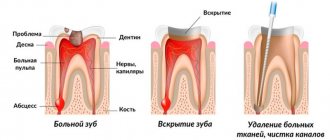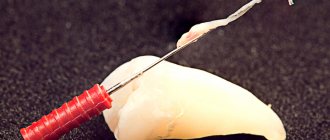Content:
- When is a non-permanent filling indicated?
- Why does a tooth with a temporary filling hurt?
- When to sound the alarm
- What to do if a tooth hurts under a temporary filling
- Preventive measures
Most often, people rush to the dental clinic because of pain.
Naturally, every person hopes that he will return home with a healthy tooth. Unfortunately, this is not always the case. Often in dental practice there are situations when the doctor has to put a temporary filling instead of a permanent one. It is distinguished by its low cost and loose structure. It is loosely held in the carious cavity and quite quickly falls out on its own or decreases in volume. These features are due to the fact that the temporary filling material must be easily removed. The problems it solves:
- protection of the carious “hollow” from the accumulation of food debris and the penetration of pathogenic bacteria;
- preventing premature loss of medication from the “hole”.
Why does a tooth with a temporary filling hurt?
Often the temporary filling hurts. Among the main reasons for this problem are:
- Serious damage to dentin tissue. Injuries to dentinal tissues when treating a carious area with a drill cannot be avoided. Dentin has the ability to heal itself, but this does not happen overnight. Soon everything will return to normal - the patient just needs to be patient.
- Overheating of the dentinal zone. It happens if the doctor worked with the drill for too long and did not use water cooling in the process of cleaning the “hole”. It may also be a consequence of the use of faulty medical equipment.
- The filling height is too high. Then, when pressing on the tooth, acute pain appears. You shouldn't tolerate it. The most reasonable thing is to make an appointment with a doctor and ask him to remove the excess material. In general, this reason is rare, since before sending the patient home, a good specialist always makes sure that the material is standing properly and does not take up excessive space.
- Exceeding the prescribed treatment period. The doctor clearly announces when you need to come for a follow-up appointment to remove the stored medicine. But some people ignore such instructions and walk with the material longer. Then there is a destructive effect on the tissues of the unit, aching or acute pain appears. A medicinal composition whose service life has long expired becomes toxic. It disrupts metabolic processes occurring in local tissues. Promotes crown destruction. Cracks form on the surface of the latter.
- Individual intolerance to the prescribed filling composition. Sometimes in dental practice there are allergies to the drugs used. Then, after laying the material, swelling appears. The tooth starts to hurt.
- Partial destruction of the seal. The formed depression may be very small and, quite possibly, the person will not even notice that any changes have occurred to his tooth. Meanwhile, pathogenic organisms will begin to penetrate through the hole that appears into the deep tissues. This will cause inflammation. The unit will begin to react painfully to temperature changes, spicy, salty and sour foods.
It is important to understand what is causing the pain symptoms. The patient cannot do this on his own, since this involves an in-person examination in the dentist’s office. You need to make an appointment with a doctor as soon as possible and undergo the treatment he suggests.
We put medicine on a tooth and it hurts, how to distinguish the reaction
Let's look at what can be put inside the root space:
- When it is necessary to remove a nerve, a pulp necrotizing agent (arsenic-based) is used. In modern versions, an anesthetic is added and there should be practically no reactions from the chewing element.
- If the neurovascular bundle is removed, calcium hydroxide-based materials are placed. It prevents the conditions for the viability of bacteria and at the same time has a reparative effect on periodontal tissue so that they can recover. In this case, it may be that when you put the medicine in the tooth it hurts and you feel discomfort while biting. The reaction normally lasts from 10 to 14 days, gradually decreasing.
If you put medicine in the tooth and it hurts, a pulsating reaction appears, you need to see a dentist. Since the cause may be increased inflammation or a reaction to the installed material, and they need to be eliminated.
When to sound the alarm
Is it normal for a tooth with a temporary filling to hurt a lot? No. Mild discomfort is possible, but long-lasting acute pain is a reason to visit the doctor again. However, this should be done as soon as possible. It is especially dangerous if a person’s well-being worsens at night, swelling has formed or a purulent “bump” has appeared - all this may indicate the rapid progression of dangerous complications.
What kind of pain can there be and what problem does it indicate:
- The tooth aches constantly. The state of health after the last visit to the dentist does not worsen, but does not improve either. This is possible if you are allergic to a dental composition, use too high a dose of the drug (intoxication occurred due to an overdose), or use a very low dose of the drug (the infection could not be stopped and it continues to actively progress).
- Discomfort appears only when pressing on the diseased unit. Here one should suspect traumatic damage to the periodontium due to the artificial overestimation of the dental crown.
- Unbearable pain appears even with a slight touch to the tooth. Perhaps a fragment of a medical instrument remains in the canal or acute periodontitis has developed.
- There are attacks of pain. This happens when the purulent form of pulpitis is advanced.
The effect of arsenic on a tooth after the canals have been cleaned and the medicine has been applied.
A dangerous dose of arsenic for humans is considered to be 5–15 milligrams. However, dentists do not use pure arsenic, but a paste. It includes:
- anhydride ;
- anesthetic (usually Lidocaine or Novocaine);
- a drug with an antiseptic effect (Thymol, carbolic acid or Camphor);
- a substance that inhibits penetration into the pulp (Tannin);
- filler to give it a spherical shape.
Before placing arsenic on the tooth, the cavity is cleaned and carious tissue and dentin are removed. After these measures are completed, arsenic paste is applied Under the influence of the drug, nerve cells die, blood stops feeding the pulp, and the supply of impulses to the nerve endings stops .
Important! All these processes should calm the toothache (but this does not mean that treatment can be interrupted at this point). After a temporary filling has been installed, the tooth may still hurt for some time.
They put a drug on to kill the nerve, but it hurts
After arsenic is placed in the canal, the pain should go away, since the paste contains an anesthetic .
But sometimes the tooth continues to hurt, sometimes even worse than before. This happens for several reasons:
- insufficient dose of arsenic;
- long-term wearing of a filling;
- inflammation of periodontal tissues;
- necrosis ;
- intolerable substances included in the filling;
- incorrect installation of the seal.
The dentist determines how much medication to put into the filling in relation to each client individually . And if the dose is too small, the nerve will not be killed, and it will continue to bother. In some cases, the pain goes away only on day 3 (if arsenic slowly penetrates the pulp).
Important! Pain may also indicate that the installed filling is putting pressure on the pulp. Therefore, if a tooth hurts for more than three hours, you can return to the dentist to reinstall the filling under less pressure.
Why does it hurt when pressed after cleaning the canals?
One of the common misconceptions of patients is that after cleaning the canals, the tooth cannot hurt. There is some truth in this, but it is not so simple. The nerve fibers exit through the superior opening in the root and unite into thicker trunks .
One of these trunks may be responsible for the sensitivity of the entire half of the face. This explains the pain passing through the entire nerve if the inflammation affects only one tooth.
When a nerve is removed, it is only separated from the common trunk, thereby causing inevitable tissue damage.
Canal cleaning is carried out under anesthesia, which does not allow the patient to feel when the instrument passes through the tooth. If you do not pay due attention to this procedure, a hematoma may occur at the root apex. It will cause pain when pressed.
Mild discomfort is allowed for no more than two days . If the doctor did everything correctly and carefully processed the canals, leaving lint and antiseptic in them, then there should be no problems. If, after some period of time, after treatment, the patient notices severe pain, repeated cleaning of the root canals is required. The procedure must be carried out as quickly as possible; the pain cannot be tolerated or muffled with the help of medications.
Also, one of the reasons for pain when pressing is a crack in the tooth. The incisor becomes more sensitive, especially when chewing solid food.
Pain when touched may occur in patients who have recently had crowns placed. Since in the process of grinding a tooth to fit the shape of a crown, the doctor may accidentally provoke an inflammatory process in the nerve.
Important! Nerve damage can also occur during treatment. If a tooth hurts when pressed under a filling, then this is one of the signs of periodontitis. The disease may appear due to wearing old crowns that have long been due for replacement.
What to do if a tooth hurts under a temporary filling
The first thing a patient should do is get qualified medical care. Remember: for acute pain, all dentists accept appointments without an appointment. If for some reason a visit to the dentist has to be postponed for one or two days (for example, discomfort occurred on the weekend), you will have to self-medicate. This may include:
- Taking a safe analgesic. It is advisable to consult with your dentist in advance about acceptable medications that reduce pain symptoms. Such drugs should always be selected on an individual basis, as they have a large number of side effects and contraindications.
- Rinsing the mouth with a solution of salt or soda. Decoctions of chamomile and sage have proven themselves well. It is also acceptable to periodically apply an anesthetic dental gel to the gums.
It is possible that after the examination the specialist will say that there is no cause for concern. Then the patient will have to complete the prescribed period, relieving pain with analgesics.
Under no circumstances should you force the process of replacing a temporary filling material with a permanent one. This can lead to serious complications in the future. Then you will have to unseal and carry out treatment from the very beginning.
Preventive measures
In order for the process of preparing for the main treatment to proceed without unpleasant surprises and dangerous complications, you must follow simple rules:
- Try not to put stress on the sealed unit. This means that you should chew food from the “healthy side”. Under no circumstances should you chew on foreign objects. Also, intensive rinsing should not be done unless prescribed by a doctor.
- Maintain good oral hygiene. It is necessary to carry out hygiene measures in the morning and evening. Inflamed areas of the gums can be treated with a brush with soft bristles.
- Check the temporary filling for cracks and chips. If they appear, a re-sealing should be carried out. Otherwise, by the time the permanent material is installed, there may be nothing left of the dental crown - it will collapse under the aggressive influence of pathogens.
Watch your tooth filled with a temporary filling carefully. Then you will avoid many problems.
Why is medicine placed under the filling, and how long do you need to walk with it?
To remove the nerve, an arsenic-based medicine is placed into the tooth cavity, which promotes necrotization of the pulp. Modern products may also contain an antiseptic. In all other cases, preparations with calcium hydroxide are used. The medicine disinfects the tooth cavity and accelerates metabolic processes in periodontal tissues. When a filling is placed, a dental unit can normally hurt for about 2 weeks.
Most often, arsenic is used in the treatment of pulpitis (we recommend reading: how to remove arsenic from a tooth at home?). The medicinal paste leads to necrosis of blood vessels and nerves. When all nerve endings are removed, the risk of complications is minimal. In addition, the tooth will lose sensitivity, so all further manipulations by the doctor will be painless for the patient.
For pulpitis, different types of medicinal pastes are used depending on their duration of action. The desired effect can be achieved in a few days, sometimes treatment takes up to 2 weeks. The doctor will tell you exactly how long to keep the medicine. If the medicine remains in the tooth cavity for too long, it will lead to necrosis of the periodontal and hard dental tissues.
When the nerve is removed, the doctor often re-installs a temporary filling after placing an anti-inflammatory drug into the hole. In this case, it is recommended to come for an appointment after 7 days. The medicine will not cause any harm to the patient’s health, even if you walk with it for 2-3 weeks.
Treatment of periodontitis requires a special approach. This disease cannot be cured in one go. Depending on the severity of the pathology, the doctor determines which medicine can relieve inflammation and how long the patient will have to walk with a temporary filling.
To save a tooth, it is necessary to restore the bone tissue. Assessing the current condition of the dental unit, the specialist replaces one temporary filling with another.
Many people do not understand why, before the upcoming prosthetics, dentists install a temporary filling on already filled canals. This is done in order to avoid possible problems after installing the pin. The tooth is also covered with filling material to secure the removable structure, while the temporary filling can be left in place for a long time.










